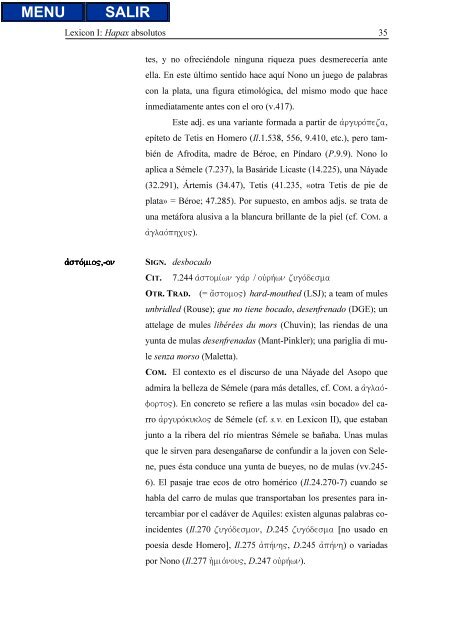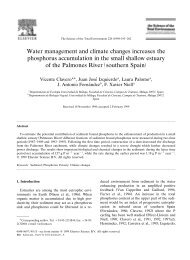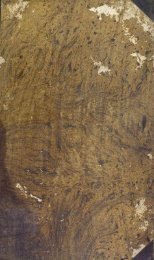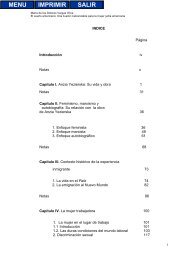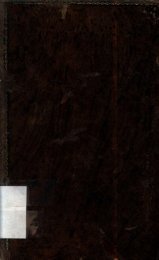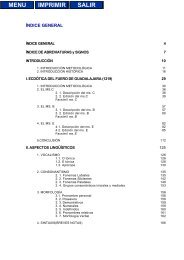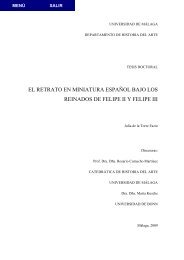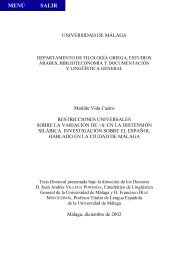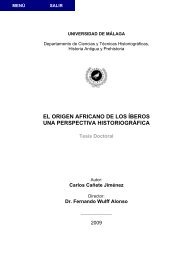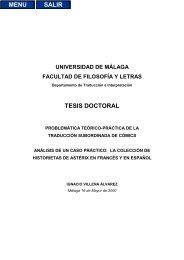- Page 1 and 2:
D.ª INÉS CALERO SECALL, Profesora
- Page 3 and 4: Agradecimientos Una Tesis Doctoral
- Page 5: oÙ crÁ k£koisi qàmon pitršphn,
- Page 8 and 9: Objetivos, metodología y estructur
- Page 10 and 11: Objetivos, metodología y estructur
- Page 12 and 13: Objetivos, metodología y estructur
- Page 14 and 15: Objetivos, metodología y estructur
- Page 16 and 17: Objetivos, metodología y estructur
- Page 18: Objetivos, metodología y estructur
- Page 21 and 22: Introducción: Nono y las Dionisía
- Page 23 and 24: Introducción: Nono y las Dionisía
- Page 25 and 26: Introducción: Nono y las Dionisía
- Page 27 and 28: Introducción: Nono y las Dionisía
- Page 29 and 30: Introducción: Nono y las Dionisía
- Page 31: Introducción: Nono y las Dionisía
- Page 34 and 35: Lexicon I: Hapax absolutos GRETON A
- Page 36 and 37: Lexicon I: Hapax absolutos (Descrip
- Page 38 and 39: Lexicon I: Hapax absolutos tru". Pa
- Page 40 and 41: Lexicon I: Hapax absolutos ración,
- Page 42 and 43: Lexicon I: Hapax absolutos movimien
- Page 44 and 45: Lexicon I: Hapax absolutos ciones d
- Page 46 and 47: Lexicon I: Hapax absolutos aJliergo
- Page 48 and 49: Lexicon I: Hapax absolutos ajlkthvr
- Page 50 and 51: Lexicon I: Hapax absolutos ajmivtrw
- Page 52 and 53: Lexicon I: Hapax absolutos a[nnwsto
- Page 56 and 57: Lexicon I: Hapax absolutos ajteirhv
- Page 58 and 59: Lexicon I: Hapax absolutos aujloman
- Page 60 and 61: Lexicon I: Hapax absolutos OTR. TRA
- Page 62 and 63: Lexicon I: Hapax absolutos ajcuvtlw
- Page 64 and 65: Lexicon I: Hapax absolutos no son o
- Page 66 and 67: Lexicon I: Hapax absolutos tros. Po
- Page 68 and 69: Lexicon I: Hapax absolutos lares Si
- Page 70 and 71: Lexicon I: Hapax absolutos COM. La
- Page 72 and 73: Lexicon I: Hapax absolutos que form
- Page 74 and 75: Lexicon I: Hapax absolutos dios y l
- Page 76 and 77: Lexicon I: Hapax absolutos el secun
- Page 78 and 79: Lexicon I: Hapax absolutos mon), co
- Page 80 and 81: Lexicon I: Hapax absolutos mos adem
- Page 82 and 83: Lexicon I: Hapax absolutos ejugluvf
- Page 84 and 85: Lexicon I: Hapax absolutos Nuestro
- Page 86 and 87: Lexicon I: Hapax absolutos ocurre c
- Page 88 and 89: Lexicon I: Hapax absolutos COM. La
- Page 90 and 91: Lexicon I: Hapax absolutos patronos
- Page 92 and 93: Lexicon I: Hapax absolutos crops, m
- Page 94 and 95: Lexicon I: Hapax absolutos comparac
- Page 96 and 97: Lexicon I: Hapax absolutos ijsovfqo
- Page 98 and 99: Lexicon I: Hapax absolutos NÁNDEZ
- Page 100 and 101: Lexicon I: Hapax absolutos Ágave y
- Page 102 and 103: Lexicon I: Hapax absolutos califica
- Page 104 and 105:
Lexicon I: Hapax absolutos cia. La
- Page 106 and 107:
Lexicon I: Hapax absolutos ojos de
- Page 108 and 109:
Lexicon I: Hapax absolutos lipovqro
- Page 110 and 111:
Lexicon I: Hapax absolutos la batal
- Page 112 and 113:
Lexicon I: Hapax absolutos en Apolo
- Page 114 and 115:
Lexicon I: Hapax absolutos Night; t
- Page 116 and 117:
Lexicon I: Hapax absolutos nekussov
- Page 118 and 119:
Lexicon I: Hapax absolutos ajmovsce
- Page 120 and 121:
Lexicon I: Hapax absolutos 100 hijo
- Page 122 and 123:
Lexicon I: Hapax absolutos 102 sus
- Page 124 and 125:
Lexicon I: Hapax absolutos 104 el c
- Page 126 and 127:
Lexicon I: Hapax absolutos 106 hapa
- Page 128 and 129:
Lexicon I: Hapax absolutos 108 hijo
- Page 130 and 131:
Lexicon I: Hapax absolutos 110 OTR.
- Page 132 and 133:
Lexicon I: Hapax absolutos 112 con
- Page 134 and 135:
Lexicon I: Hapax absolutos pelidnai
- Page 136 and 137:
Lexicon I: Hapax absolutos 116 en o
- Page 138 and 139:
Lexicon I: Hapax absolutos 118 flè
- Page 140 and 141:
Lexicon I: Hapax absolutos 120 to c
- Page 142 and 143:
Lexicon I: Hapax absolutos 122 la»
- Page 144 and 145:
Lexicon I: Hapax absolutos 124 copi
- Page 146 and 147:
Lexicon I: Hapax absolutos 126 CIT.
- Page 148 and 149:
Lexicon I: Hapax absolutos 128 Aqu
- Page 150 and 151:
Lexicon I: Hapax absolutos 130 horr
- Page 152 and 153:
Lexicon I: Hapax absolutos 132 Tene
- Page 154 and 155:
Lexicon I: Hapax absolutos 134 cuch
- Page 156 and 157:
Lexicon I: Hapax absolutos 136 COM.
- Page 158 and 159:
Lexicon I: Hapax absolutos 138 OTR.
- Page 160 and 161:
Lexicon I: Hapax absolutos 140 ce e
- Page 162 and 163:
Lexicon I: Hapax absolutos 142 Nues
- Page 164 and 165:
Lexicon I: Hapax absolutos 144 Beri
- Page 166 and 167:
Lexicon I: Hapax absolutos 146 OTR.
- Page 168 and 169:
Lexicon I: Hapax absolutos uJpathvi
- Page 170 and 171:
Lexicon I: Hapax absolutos uJyipovq
- Page 172 and 173:
Lexicon I: Hapax absolutos 152 las
- Page 174 and 175:
Lexicon I: Hapax absolutos 154 hech
- Page 176 and 177:
Lexicon I: Hapax absolutos 156 CIT.
- Page 178 and 179:
Lexicon I: Hapax absolutos Dindumiv
- Page 180 and 181:
Lexicon I: Hapax absolutos 160 vant
- Page 182 and 183:
Lexicon I: Hapax absolutos 162 amon
- Page 184 and 185:
Lexicon I: Hapax absolutos Stumfall
- Page 186 and 187:
Lexicon I: Hapax absolutos 166 atri
- Page 188 and 189:
Lexicon I: Hapax absolutos jWkeanhi
- Page 191 and 192:
LEXICON II Lista alfabética de tod
- Page 193 and 194:
Lexicon II: Hapax no absolutos 172
- Page 195 and 196:
Lexicon II: Hapax no absolutos 174
- Page 197 and 198:
Lexicon II: Hapax no absolutos 176
- Page 199 and 200:
Lexicon II: Hapax no absolutos 178
- Page 201 and 202:
Lexicon II: Hapax no absolutos 180
- Page 203 and 204:
Lexicon II: Hapax no absolutos 182
- Page 205 and 206:
Lexicon II: Hapax no absolutos ajrg
- Page 207 and 208:
Lexicon II: Hapax no absolutos aujt
- Page 209 and 210:
Lexicon II: Hapax no absolutos baru
- Page 211 and 212:
Lexicon II: Hapax no absolutos dafo
- Page 213 and 214:
Lexicon II: Hapax no absolutos 192
- Page 215 and 216:
Lexicon II: Hapax no absolutos 194
- Page 217 and 218:
Lexicon II: Hapax no absolutos 196
- Page 219 and 220:
Lexicon II: Hapax no absolutos 198
- Page 221 and 222:
Lexicon II: Hapax no absolutos 200
- Page 223 and 224:
Lexicon II: Hapax no absolutos 202
- Page 225 and 226:
Lexicon II: Hapax no absolutos 204
- Page 227 and 228:
Lexicon II: Hapax no absolutos 206
- Page 229 and 230:
Lexicon II: Hapax no absolutos ijqu
- Page 231 and 232:
Lexicon II: Hapax no absolutos 210
- Page 233 and 234:
Lexicon II: Hapax no absolutos 212
- Page 235 and 236:
Lexicon II: Hapax no absolutos liqo
- Page 237 and 238:
Lexicon II: Hapax no absolutos 216
- Page 239 and 240:
Lexicon II: Hapax no absolutos 218
- Page 241 and 242:
Lexicon II: Hapax no absolutos neht
- Page 243 and 244:
Lexicon II: Hapax no absolutos 222
- Page 245 and 246:
Lexicon II: Hapax no absolutos COM.
- Page 247 and 248:
Lexicon II: Hapax no absolutos 226
- Page 249 and 250:
Lexicon II: Hapax no absolutos 228
- Page 251 and 252:
Lexicon II: Hapax no absolutos 230
- Page 253 and 254:
Lexicon II: Hapax no absolutos 232
- Page 255 and 256:
Lexicon II: Hapax no absolutos 234
- Page 257 and 258:
Lexicon II: Hapax no absolutos 236
- Page 259 and 260:
Lexicon II: Hapax no absolutos 238
- Page 261 and 262:
Lexicon II: Hapax no absolutos 240
- Page 263 and 264:
Lexicon II: Hapax no absolutos pole
- Page 265 and 266:
Lexicon II: Hapax no absolutos molt
- Page 267 and 268:
Lexicon II: Hapax no absolutos 246
- Page 269 and 270:
Lexicon II: Hapax no absolutos 248
- Page 271 and 272:
Lexicon II: Hapax no absolutos 250
- Page 273 and 274:
Lexicon II: Hapax no absolutos 252
- Page 275 and 276:
Lexicon II: Hapax no absolutos 254
- Page 277 and 278:
Lexicon II: Hapax no absolutos tefr
- Page 279 and 280:
Lexicon II: Hapax no absolutos 258
- Page 281 and 282:
Lexicon II: Hapax no absolutos uJgr
- Page 283 and 284:
Lexicon II: Hapax no absolutos 262
- Page 285 and 286:
Lexicon II: Hapax no absolutos filo
- Page 287 and 288:
Lexicon II: Hapax no absolutos 266
- Page 289 and 290:
Lexicon II: Hapax no absolutos cion
- Page 291 and 292:
Lexicon II: Hapax no absolutos 270
- Page 293 and 294:
Lexicon II: Hapax no absolutos Apé
- Page 295 and 296:
Lexicon II: Hapax no absolutos 274
- Page 297 and 298:
Lexicon II: Hapax no absolutos 276
- Page 299 and 300:
Lexicon II: Hapax no absolutos 278
- Page 301 and 302:
Lexicon II: Hapax no absolutos 280
- Page 303 and 304:
Lexicon II: Hapax no absolutos Lhla
- Page 305 and 306:
Lexicon II: Hapax no absolutos 284
- Page 307 and 308:
Lexicon II: Hapax no absolutos jOfi
- Page 309 and 310:
Lexicon II: Hapax no absolutos 288
- Page 312 and 313:
Períocas INDEX I Lista de todos lo
- Page 314 and 315:
Index I: Hapax por orden de aparici
- Page 316 and 317:
Index I: Hapax por orden de aparici
- Page 318 and 319:
Index I: Hapax por orden de aparici
- Page 320 and 321:
Index I: Hapax por orden de aparici
- Page 322 and 323:
Index I: Hapax por orden de aparici
- Page 324 and 325:
Index I: Hapax por orden de aparici
- Page 326 and 327:
Index I: Hapax por orden de aparici
- Page 328 and 329:
Index I: Hapax por orden de aparici
- Page 330 and 331:
Index I: Hapax por orden de aparici
- Page 332 and 333:
Index I: Hapax por orden de aparici
- Page 334 and 335:
Index I: Hapax por orden de aparici
- Page 336 and 337:
Index I: Hapax por orden de aparici
- Page 339 and 340:
Index II: Neologismos adjetivales n
- Page 341 and 342:
Index II: Neologismos adjetivales n
- Page 343 and 344:
Index II: Neologismos adjetivales n
- Page 345 and 346:
Index II: Neologismos adjetivales n
- Page 347 and 348:
Index II: Neologismos adjetivales n
- Page 349 and 350:
Index II: Neologismos adjetivales n
- Page 351 and 352:
Index II: Neologismos adjetivales n
- Page 353 and 354:
Index II: Neologismos adjetivales n
- Page 355 and 356:
Index II: Neologismos adjetivales n
- Page 357 and 358:
Index II: Neologismos adjetivales n
- Page 359 and 360:
Index II: Neologismos adjetivales n
- Page 361 and 362:
Index II: Neologismos adjetivales n
- Page 363 and 364:
Index II: Neologismos adjetivales n
- Page 365 and 366:
Index II: Neologismos adjetivales n
- Page 368 and 369:
Conclusiones Conclusiones Tras la a
- Page 370 and 371:
Conclusiones bhv", polublevfaro" co
- Page 372:
Conclusiones autores más sorprende
- Page 375 and 376:
Bibliografía A. KOECHLY, Nonni Pan
- Page 377 and 378:
Bibliografía B- EDICIONES Y TRADUC
- Page 379 and 380:
Bibliografía F. PASSOW, Specimen n
- Page 381 and 382:
Bibliografía D -MONOGRAFÍAS Y TES
- Page 383 and 384:
Bibliografía A. KREUTZ, De differe
- Page 385 and 386:
Bibliografía G. WILD, Die Vergleic
- Page 387 and 388:
Bibliografía J. ARCE, “El mosaic
- Page 389 and 390:
Bibliografía J.L. BUTRICA, “A pl
- Page 391 and 392:
Bibliografía -, “Contribution à
- Page 393 and 394:
Bibliografía -, “Heidnisches und
- Page 395 and 396:
Bibliografía A.W. JAMES, “Some E
- Page 397 and 398:
Bibliografía -, “Per il testo di
- Page 399 and 400:
Bibliografía M. PAPATHOMOPOULOS,
- Page 401 and 402:
Bibliografía -, “Eros und Hymena
- Page 403 and 404:
Bibliografía -, “Ma/rtuj chez No
- Page 405 and 406:
Bibliografía F- OTRAS OBRAS DE REF
- Page 407 and 408:
Índice griego 382 Este índice com
- Page 409 and 410:
kakonuvmfio",-on kakonuvmfio",-on :
- Page 411 and 412:
calkeo calkeovnwto",-on calkeo vnwt
- Page 413:
LISTA DE ABREVIATURAS .............


